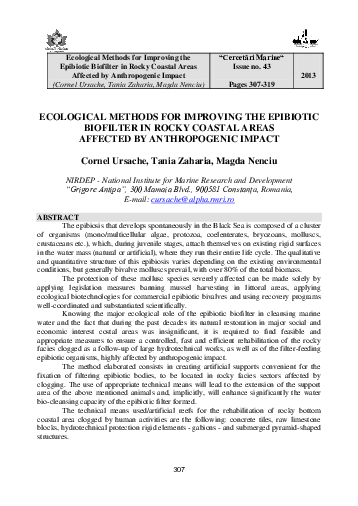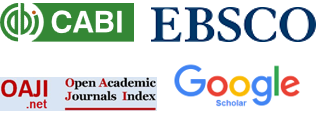Ecological Methods for Improving the Epibiotic Biofilter in Rocky Coastal Areas Affected by Anthropogenic Impact
DOI:
https://doi.org/10.55268/CM.2013.43.307Keywords:
epibiosis, biofilters, bivalves, artificial supportsAbstract
The epibiosis that develops spontaneously in the Black Sea is composed of a cluster of organisms (mono/multicellular algae, protozoa, coelenterates, bryozoans, molluscs, crustaceans etc.), which, during juvenile stages, attach themselves on existing rigid surfaces in the water mass (natural or artificial), where they run their entire life cycle. The qualitative and quantitative structure of this epibiosis varies depending on the existing environmental conditions, but generally bivalve molluscs prevail, with over 80% of the total biomass. The protection of these mollusc species severely affected can be made solely by applying legislation measures banning mussel harvesting in littoral areas, applying ecological biotechnologies for commercial epibiotic bivalves and using recovery programs well-coordinated and substantiated scientifically. Knowing the major ecological role of the epibiotic biofilter in cleansing marine water and the fact that during the past decades its natural restoration in major social and economic interest costal areas was insignificant, it is required to find feasible and appropriate measures to ensure a controlled, fast and efficient rehabilitation of the rocky facies clogged as a follow-up of large hydrotechnical works, as well as of the filter-feeding epibiotic organisms, highly affected by anthropogenic impact. The method elaborated consists in creating artificial supports convenient for the fixation of filtering epibiotic bodies, to be located in rocky facies sectors affected by clogging. The use of appropriate technical means will lead to the extension of the support area of the above mentioned animals and, implicitly, will enhance significantly the water bio-cleansing capacity of the epibiotic filter formed. The technical means used/artificial reefs for the rehabilitation of rocky bottom coastal area clogged by human activities are the following: concrete tiles, raw limestone blocks, hydrotechnical protection rigid elements - gabions - and submerged pyramid-shaped Structures. Based on the results obtained in experimental work on the sea water biofiltering capacity by epibiotic organisms, one kg of epibiotic filter-feeding juveniles, of which mussels are 90% of the reference amount, can cleanse, during a 24 hour cycle and up to 85 ÷ 90%, a volume of approx. 73 m3 of sea water, with a phytoplankton load of approx. 18 mil. cells/liter. This production technology of marine epibiosis on artificial supports is a purely ecological method, aimed at improving marine water quality in tourist coastal areas by means of local epibiotic biofilters.
Downloads
Published
2013-12-20
How to Cite
Ursache, C., Zaharia, T., & Nenciu, M. (2013). Ecological Methods for Improving the
Epibiotic Biofilter in Rocky Coastal Areas
Affected by Anthropogenic Impact. Cercetări Marine - Recherches Marines, 43(1), 307–319. https://doi.org/10.55268/CM.2013.43.307
Issue
Section
ORIGINAL ARTICLES
License
This is an open access journal, which means that all content is freely available without charge to the user or his/her institution. Users are allowed to read, download, copy, distribute, print, search, or link to the full texts of the articles, or use them for any other lawful purpose, without asking prior permission from the publisher or the author. This is in accordance with the BOAI definition of open access.






